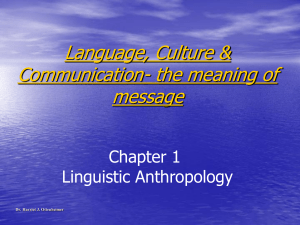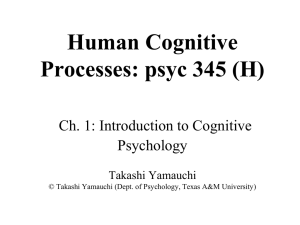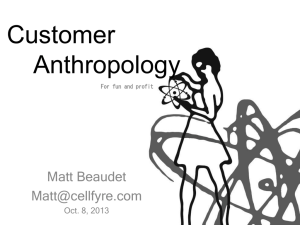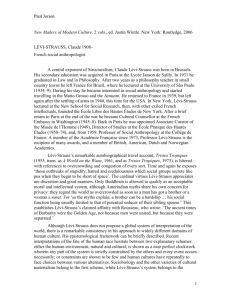Strukturalista antrop
advertisement
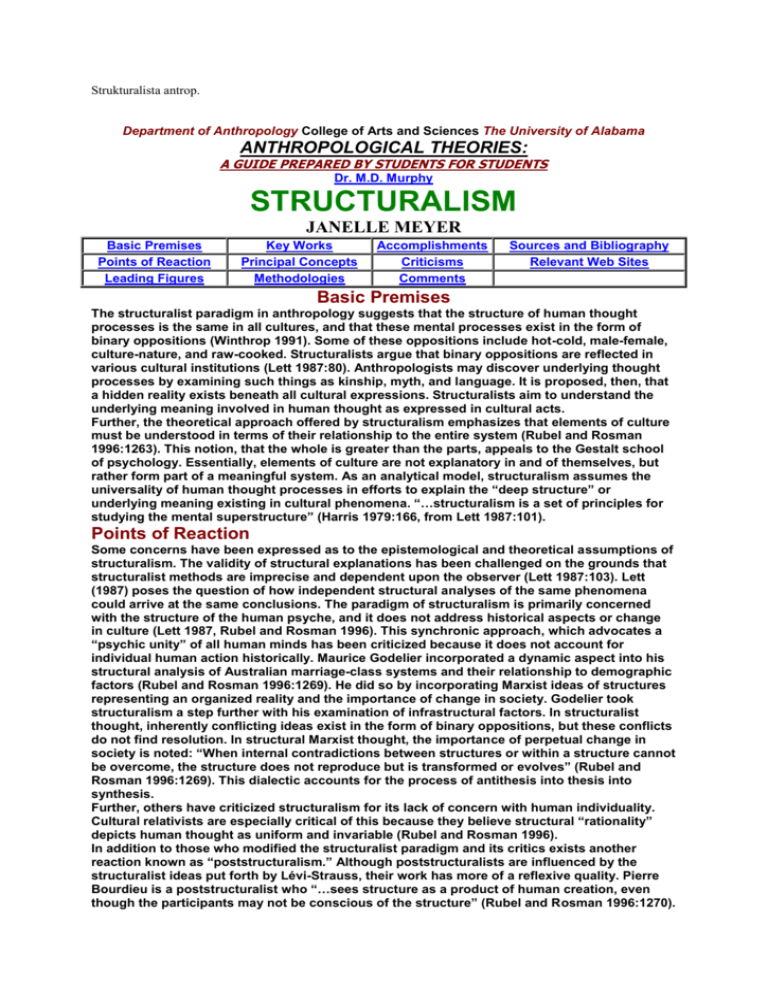
Strukturalista antrop. Department of Anthropology College of Arts and Sciences The University of Alabama ANTHROPOLOGICAL THEORIES: A GUIDE PREPARED BY STUDENTS FOR STUDENTS Dr. M.D. Murphy STRUCTURALISM JANELLE MEYER Basic Premises Points of Reaction Leading Figures Key Works Principal Concepts Methodologies Accomplishments Criticisms Comments Sources and Bibliography Relevant Web Sites Basic Premises The structuralist paradigm in anthropology suggests that the structure of human thought processes is the same in all cultures, and that these mental processes exist in the form of binary oppositions (Winthrop 1991). Some of these oppositions include hot-cold, male-female, culture-nature, and raw-cooked. Structuralists argue that binary oppositions are reflected in various cultural institutions (Lett 1987:80). Anthropologists may discover underlying thought processes by examining such things as kinship, myth, and language. It is proposed, then, that a hidden reality exists beneath all cultural expressions. Structuralists aim to understand the underlying meaning involved in human thought as expressed in cultural acts. Further, the theoretical approach offered by structuralism emphasizes that elements of culture must be understood in terms of their relationship to the entire system (Rubel and Rosman 1996:1263). This notion, that the whole is greater than the parts, appeals to the Gestalt school of psychology. Essentially, elements of culture are not explanatory in and of themselves, but rather form part of a meaningful system. As an analytical model, structuralism assumes the universality of human thought processes in efforts to explain the “deep structure” or underlying meaning existing in cultural phenomena. “…structuralism is a set of principles for studying the mental superstructure” (Harris 1979:166, from Lett 1987:101). Points of Reaction Some concerns have been expressed as to the epistemological and theoretical assumptions of structuralism. The validity of structural explanations has been challenged on the grounds that structuralist methods are imprecise and dependent upon the observer (Lett 1987:103). Lett (1987) poses the question of how independent structural analyses of the same phenomena could arrive at the same conclusions. The paradigm of structuralism is primarily concerned with the structure of the human psyche, and it does not address historical aspects or change in culture (Lett 1987, Rubel and Rosman 1996). This synchronic approach, which advocates a “psychic unity” of all human minds has been criticized because it does not account for individual human action historically. Maurice Godelier incorporated a dynamic aspect into his structural analysis of Australian marriage-class systems and their relationship to demographic factors (Rubel and Rosman 1996:1269). He did so by incorporating Marxist ideas of structures representing an organized reality and the importance of change in society. Godelier took structuralism a step further with his examination of infrastructural factors. In structuralist thought, inherently conflicting ideas exist in the form of binary oppositions, but these conflicts do not find resolution. In structural Marxist thought, the importance of perpetual change in society is noted: “When internal contradictions between structures or within a structure cannot be overcome, the structure does not reproduce but is transformed or evolves” (Rubel and Rosman 1996:1269). This dialectic accounts for the process of antithesis into thesis into synthesis. Further, others have criticized structuralism for its lack of concern with human individuality. Cultural relativists are especially critical of this because they believe structural “rationality” depicts human thought as uniform and invariable (Rubel and Rosman 1996). In addition to those who modified the structuralist paradigm and its critics exists another reaction known as “poststructuralism.” Although poststructuralists are influenced by the structuralist ideas put forth by Lévi-Strauss, their work has more of a reflexive quality. Pierre Bourdieu is a poststructuralist who “…sees structure as a product of human creation, even though the participants may not be conscious of the structure” (Rubel and Rosman 1996:1270). Instead of the structuralist notion of the universality of human thought processes found in the structure of the human mind, Bourdieu proposes that dominant thought processes are a product of society and determine how people act (Rubel and Rosman 1996). However, in poststructuralist methods, the person describing the thought processes of people of another culture may be reduced to just that—description—as interpretation imposes the observer’s perceptions onto the analysis at hand (Rubel and Rosman 1996). Poststructuralism is much like postmodernism in this sense. Materialists would also generally object to structural explanations in favor of more observable or practical explanations. As Lett (1987) points out, Lévi-Strauss’ analysis of the role of the coyote as “trickster” in many different Native American mythologies rationalizes that the coyote, because it preys on herbivores and carnivores alike, is associated with agriculture and hunting, and life and death (Lett 1987:104) is thus a deviation from natural order, or abnormal. Lett further shows that a materialist perspective is offered by Marvin Harris in the explanation of the recurrent theme of coyote as trickster: “The coyote enjoys the status of a trickster because it is an intelligent, opportunistic animal” (Lett 1987:104). Lévi-Strauss helped to spawn the rationalist-empiricist debate by furthering the inquiry into the idea of panhuman mental processes, and what determines culture. Another reaction to structuralism is grounded in scientific inquiry. In any form of responsible inquiry, theories must be falsifiable. Structural analyses do not allow for this or for external validation (Lett 1987). Although these analyses present “complexity of symbolic realms” and “insight about the human condition,” they simply cannot be subjected to scientific scrutiny (Lett 1987:108-9). Leading Figures Claude Lévi-Strauss: “Father of Structuralism;” born in Brussels. Obtained a law degree from the University of Paris. He became a professor of sociology at the University of Sao Paulo in Brazil in 1934. It was at this time that he began to think about human thought cross-culturally and alterity, when he was exposed to various cultures in Brazil. His first publication in anthropology appeared in 1936 and covered the social organization of the Bororo (Bohannan and Glazer 1988:423). After W.W.II, he taught at the New School for Social Research in New York. Here he met Roman Jakobson, from whom he took the structural linguistics model and applied its framework to culture (Bohannan and Glazer 1988:423). Lévi-Strauss has been noted as singly associated for the elaboration of the structuralist paradigm in anthropology (Winthrop 1991) Ferdinand de Saussure: Swiss linguist whose work in structural linguistics and semiology greatly influenced Lévi-Strauss (Winthrop 1991; Rubel and Rosman 1996). Roman Jakobson: structural linguist whose work influenced Lévi-Strauss; colleague of LéviStrauss at the New School Marcel Mauss: taught Lévi-Strauss and influenced his thought on the nature of reciprocity and structural relationships in culture (Winthrop 1991). Edmund Leach: Roland Barthes: French literary philosopher whose ideas were influenced by structuralism, but who would be opposed at being labeled a “structuralist” because that would impose one line of thought for this eclectic (Sturrock 1981). Jacques Lacan: French literary critic largely influenced by Freudian psychoanalysis; would also not admit to being a “structuralist,” but whose work reflected some of the same principles of structuralism. Known as an arrogant academic who also did not enjoy being associated with one paradigm, he did not collaborate with any of his French contemporaries (Sturrock 1981). Jacques Derrida: French social philosopher and literary critic who may be labeled both a “structuralist’ and a “poststructuralist;” wrote critiques of his contemporaries’ works, and of the notions underlying structuralism and poststructuralism (Culler 1981). Michel Foucault: French social philosopher whose works have been associated with both structuralist and poststructuralist thought, more often with the latter. When asked in an interview if he accepted being grouped with Lacan and Lévi-Strauss, he conveniently avoids a straight answer: “It’s for those who use the label [structuralism] to designate very diverse works to say what makes us “structuralists” (Lotringer 1989:60). However, he has publicly scoffed at being labeled a structuralist because he did not wish to be permanently associated with one paradigm, much like Barthes (Sturrock 1981). Foucault deals largely with issues of power in his works, that is, who has power in a society. For this reason, I would more closely associate him with poststructuralist thought. Key Works Clarke, Simon (1981) The Foundations of Structuralism. The Harvester Press: Sussex. Durkheim, Emile and Marcel Mauss (1963) Primitive Classification. University of Chicago Press: Chicago. Hage, Per and Frank Harary (1983) Structural Models in Anthropology. Cambridge University Press: Cambridge. Lane, Michael (1970) Introduction to Structuralism. Basic Books, Inc.: New York. Lévi-Strauss, Claude (1963) Structural Anthropology, Volume I. Basic Books, Inc.: New York. Lévi-Strauss, Claude (1976) Structural Anthropology, Volume II. Basic Books, Inc.: New York. Lévi-Strauss, Claude (1963) The Elementary Structures of Kinship. Beacon Press: Boston. Lévi-Strauss, Claude 1966) The Savage Mind. University of Chicago Press: Chicago. Mauss, Marcel (1967) The Gift: Forms and Functions of Exchange in Archaic Societies. Norton: New York. Merquior, J. G. (1986) From Prague to Paris: A Critique of Structuralist and PostStructuralist Thought. Thetford Press: Thetford, Norfolk. Millet, Louis and Madeleine Varin d’Ainvelle (1965) Le structuralisme. Editions Universitaires: Paris. Pettit, Philip (1975) The Concept of Structuralism: A Critical Analysis. University of California Press: Berkeley. Saussure, Ferdinand de (1959) Course in General Linguistics. Charles Bally et al, eds. McGraw-Hill: New York. Sturrock, John (1986) Structuralism. Paladin Grafton Books: London. Principal Concepts Methodologies Accomplishments Criticisms Static, ahistorical nature of theory (Seymour-Smith 1986) Theory does not account for human individuality Theory does not account for independent human acts Theory does not address dynamic aspects of culture Sources Bohannan, Paul and Mark Glazer, eds. (1988) High Points in Anthropology. McGraw-Hill, Inc.: New York. Culler, Jonathan (1981) IN Structuralism and Since: From Lévi-Strauss to Derrida. John Sturrock (ed.); Oxford University Press: Oxford. Lett, James (1987) The Human Enterprise. Westview Press, Inc.: Boulder. Lotringer, Sylvère, ed. (1989) Foucault Live. Semiotexte: New York. Rubel, Paula and Abraham Rosman (1996) IN Encyclopedia of Cultural Anthropology, Volume IV. David Levinson and Melvin Ember, Eds. Henry Holt and Company: New York. Seymour-Smith, Charlotte (1986) Dictionary of Anthropology. Macmillan Press, Ltd.: London. Winthrop, Robert H. (1991) Dictionary of Concepts in Cultural Anthropology. Greenwood Press: New York. Relevant Web Sites Elements of Structuralism Structuralism A Mini-Guide to Structuralism and Hermeneutics Biogenetic Structuralism Poststructuralism Structuralism and Poststructuralism: Background Summary and Analysis Claude Levi-Strauss A Genealogy of Foucault: since 10-22-01 Return to ANTHROPOLOGICAL THEORIES: A GUIDE PREPARED BY STUDENTS FOR STUDENTS Return to Anthropology 536 Return to M.D. Murphy's Page Return to Anthropology Department Web Page Forrás: http://www.as.ua.edu/ant/Faculty/murphy/struct.htm
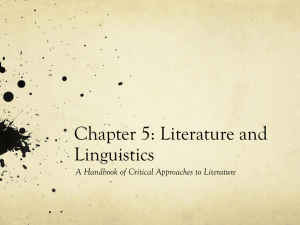
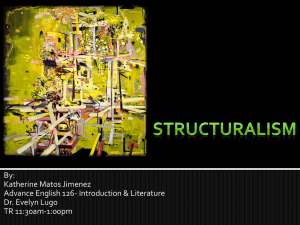
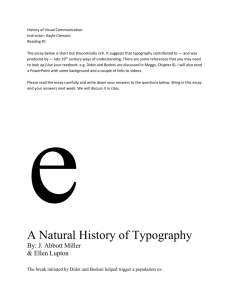


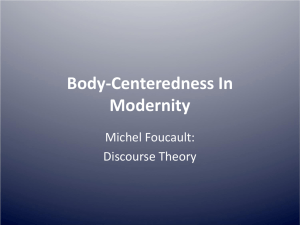
![[p. 39] Structuralist chickens and liberal humanist eggs](http://s3.studylib.net/store/data/007324837_1-1bf28210ceb0e13776c2963e3d061f23-300x300.png)

